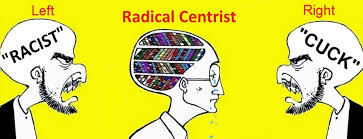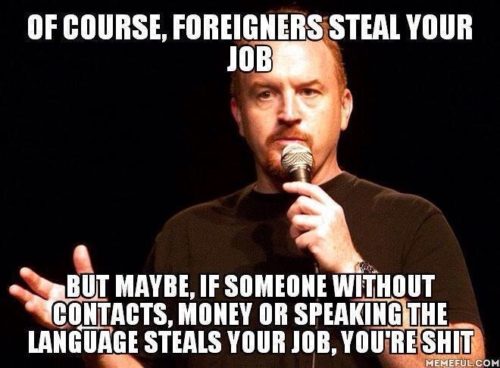
The cozy political paradigm that most of us went into 2016 with has now been completely shattered. Way back then, there was still some vague kind of belief that it was possible to strike a meaningful compromise between the various political actors on the world stage.
Now, everyone to the left of Adolf Hitler is screaming “Nazi!” at everyone to the right of Bernie Sanders, and those people are screaming “Cuck!” right back.
This means that most people are both Nazis and cucks, depending on the degree of political fanaticism of whoever is screaming at them at any given time and to which pole that person happens to have gravitated towards.
It’s an ugly scene all round.
Simply speaking, the left is a reaction to the right. The right are the same people who naturally have all the power (namely, the orderly) and the left is a reaction to this. In particular, it is a recognition by the disorderly that they have to impose some order upon themselves or lose ground in the political battlefield.
The centre is a reaction to both the left and the right. More precisely, it is a reaction to the constant fighting that once characterised the two-party (or two-pole) system. It’s an attempt to put peacefulness above all.
The alt-right is similar. The alt-right is a reaction to the left being shit and then a counter-reaction to the right being also shit. The alt-right cannot be understood unless it is seen as a double rejection, of both the left and the right.
The alt-centre, therefore, is a rejection of all of the left and the right and the centre, not to mention the alt-right and – in anticipation of it ever standing up – the alt-left: in other words, it’s a rejection of the entire political system.
This triple rejection of tired old political dogmas makes alt-centrism the real alternative way of political movements. It finally provides a solution to the balance fallacy when applied to politics.
The balance fallacy in politics occurs when a person or voting bloc decides that some kind of vague middle ground between the demands of capital (right wing) and the demands of labour (left wing) is necessarily the best compromise solution.
Note that pointing out this fallacious reasoning here does not mean that one is saying that a balance is bad in and of itself, or that either of the two extremes of left and right would be better in charge.
That is a false trilemma, which is what you get if you see through the false dilemma posed with left and right.
All three positions – pro-capital, pro-labour, and pro-compromise – are all terrible positions because they are all necessarily pro-political system. They are all positions within the broader paradigm of legitimising the use of the political system as a mechanism by which one can exploit one’s class enemies.
The reason why it is impossible to simply strike a balance is that the two wings of the political system co-operate to take power incrementally away from the populace under the pretense of striking a balance. This works in the same way that a cartel works – the members of the cartel agree to offer an equally bad deal to different groups of people.
The way forward will be the way promoted by neophyte political movements like Not A Party. This rag-tag bunch of New Zealanders, led by whoever a random number generator says is the leader on any given day, run in elections with the specific intent of losing.
They then claim the people who have not voted are their supporters, which gives them the largest number of seats in the Not A Parliament. Control of Not A Parliament allows them to not pass any laws, which makes them not responsible for things like cannabis prohibition, which costs New Zealand $400,000,000 per year.
The delusion that all questions of human suffering must be solved first and foremost through the political system is one that has to be rejected if we are actually to make any progress on those questions.
Because there are very, very, very few politicians who could rightly claim that their actions as a politician resulted in a net win for the human survival project.
*
If you enjoyed reading this essay, you can get a compilation of the Best VJMP Essays and Articles of 2017 from Amazon for Kindle or Amazon for CreateSpace (for international readers), or TradeMe (for Kiwis).



